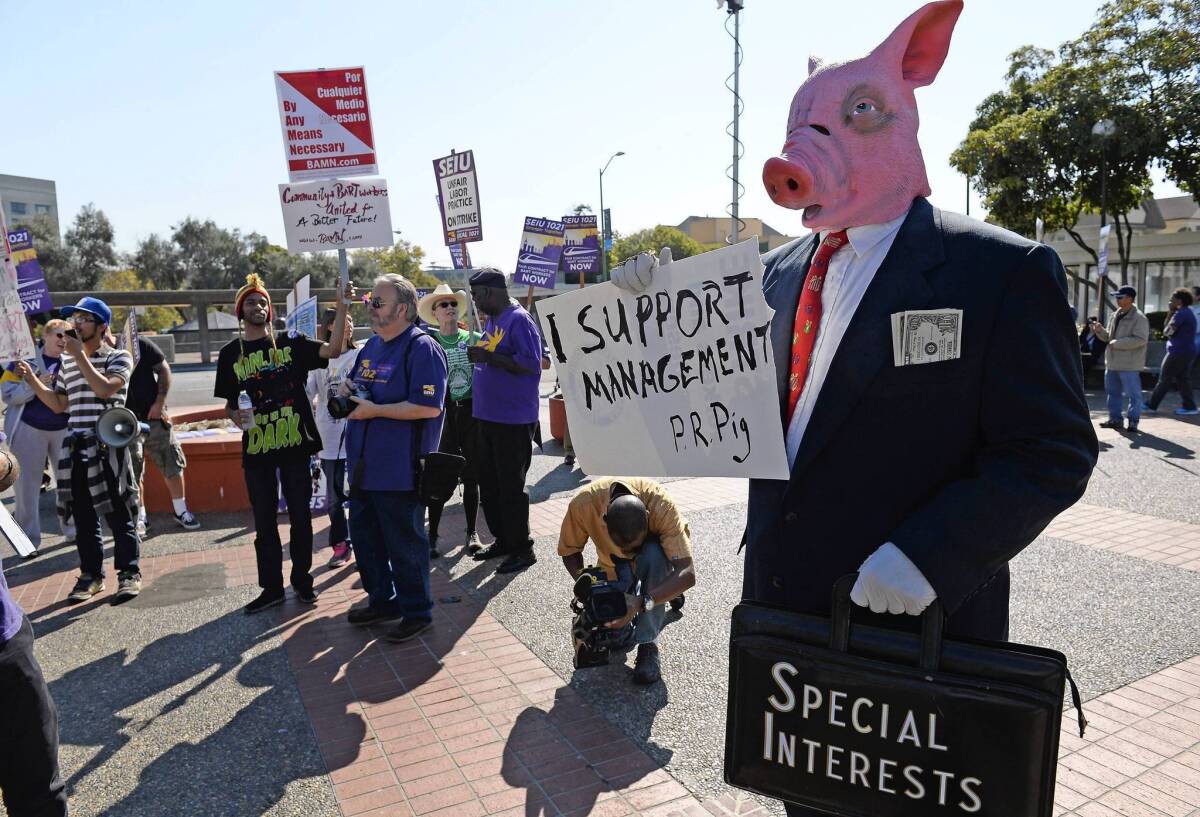Some frustration, but officials predict worst to come in BART strike

- Share via
SAN FRANCISCO — A second strike by Bay Area rapid transit workers in four months produced traffic jams and frustration Friday, but officials predicted the worst was yet to come.
Transportation officials said they believed many commuters took the day off or telecommuted, relieving the crush to get in and out of San Francisco and around the East Bay.
BART, the nation’s fifth-largest transit system, normally carries 400,000 round-trip passengers each workday. On Friday, the first day of the strike, traffic increased only 8% and car pools by 25%, according to an afternoon count by transportation officials.
Charter buses hired by BART and ferries had room in the morning for all who waited in line, with the number of riders using those forms of transportation significantly down from the 41/2 days BART workers struck in July, officials said.
“It is a three-day weekend for people,” said Randy Rentschler, a spokesman for the Metropolitan Transportation Commission. “I think a lot of people just decided to take Friday off. Monday will be more of a test.”
Commuters who got up before dawn to find seats on buses and boats probably suffered the worst commutes because congestion and lines diminished substantially later in the morning, even before 9 a.m. “The early bird had a lot of competition to get the worm,” Rentschler said. The evening commute also was heavy, with gridlock on several routes.
No new talks have been scheduled to try to break the impasse.
BART workers decided to strike Thursday after management refused to submit a dispute about work rules to binding arbitration, union leaders said. Both sides had reached an agreement on employee contributions to pensions and health plans and were close to agreeing on wages.
The July strike ended after Gov. Jerry Brown obtained a 60-day cooling-off period, but Brown indicated no intention Friday to invite the Legislature back to try to seek a solution.
“The parties can arbitrate right now and they should,” said Evan Westrup, a Brown spokesman. “An extraordinary special session at this point would not lead to the quick solution that the people of the Bay Area want and deserve.”
San Francisco State University professor John Logan, who monitored the BART negotiations as an observer, said there was “virtually nothing separating the parties on economic issues” by early Thursday.
Logan, who held his Friday class online, said BART managers’ stance “made a strike all but inevitable” and predicted it might spur support for a future ballot measure to ban transit agency strikes.
But BART General Manager Grace Crunican called the work rule concessions critical. BART workers and executives are among the highest compensated transit employees in the country.
“Using computers instead of manually recording and transmitting information is essential in the technology age,” she said in a written statement. “Managers should not have to reach mutual agreement with unions on every day-to-day operational change that is a part of a past practice. This contract component costs tens of millions of dollars each year and guarantees paralysis.”
Transportation officials prepared for more trouble on Monday should the strike persist. A BART spokeswoman said the system was considering adding more charter buses, but they still would be able to accommodate only a fraction of BART riders. AC Transit, which serves the East Bay and runs direct routes in and out of San Francisco, carried full loads Friday.
BART spokeswoman Luna Salavar said no decision had been reached on whether to permit managers to drive the trains during the walkout.
Ernest Sanchez, a spokesman for the San Francisco Bay Ferry, said only one boat carrying commuters was at full capacity Friday morning, although riders had to find street parking at some locations because of full parking lots. Having added four additional ferries, the system is able to carry nearly 20,000 passengers on workdays during the strike, compared with the usual load of 6,000.
“It was a moderate day, but nothing like the July strike,” Sanchez said. “If the strike goes into Monday, Tuesday and Wednesday, I think at that point we will see the real demand for normal fall commute.”
BART gave free round-trip tickets to 4,400 passengers on 125 buses and was considering adding 15 more coaches on Monday. The system will offer much more limited bus service over the weekend in the mornings and evenings.
Casual Carpool, in which drivers can pick up riders at designated sites, was not as heavily used as it was during the July strike. Some sites had lines of more than a dozen cars waiting to pick up commuters, and many drivers gave up and drove alone into San Francisco.
“People are frightened to get on the road,” said J. Hyjer, 59, a real estate executive who waited in Orinda to pick up passengers. “A lot of people decided to telecommute this morning.”
Some took their work to cafes with Internet service. One Twitter user vented that he would have preferred spending three hours in traffic to listening to the natter of fashion bloggers at a nearby table.
More to Read
Sign up for Essential California
The most important California stories and recommendations in your inbox every morning.
You may occasionally receive promotional content from the Los Angeles Times.














